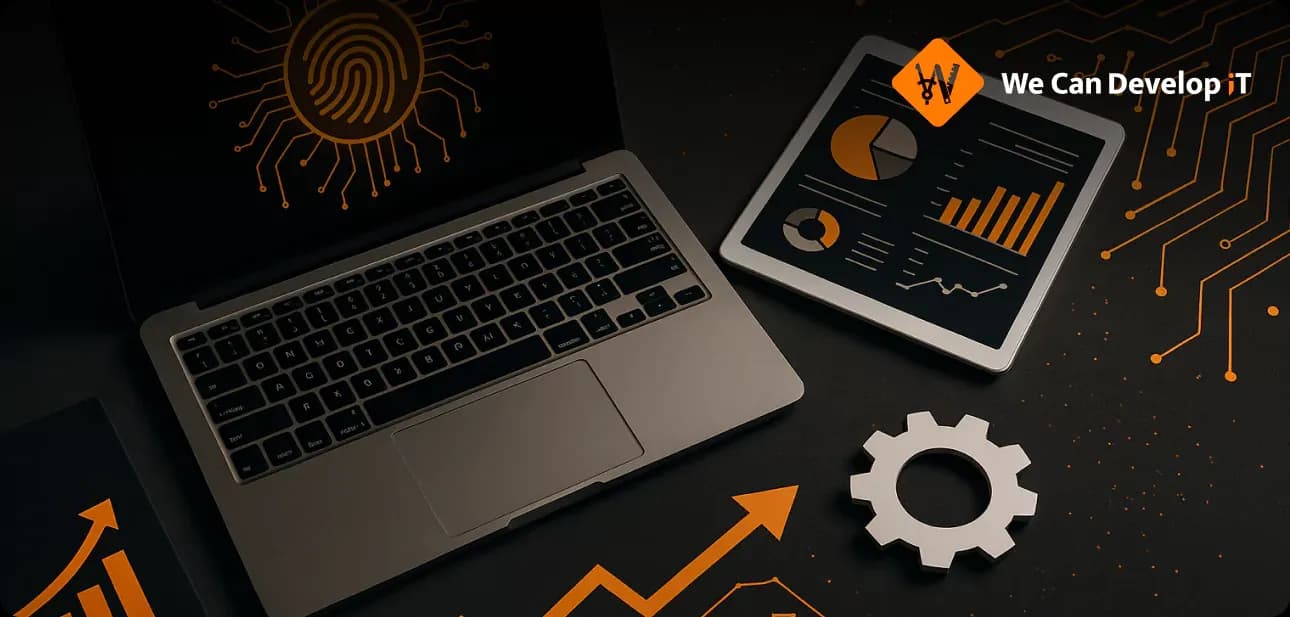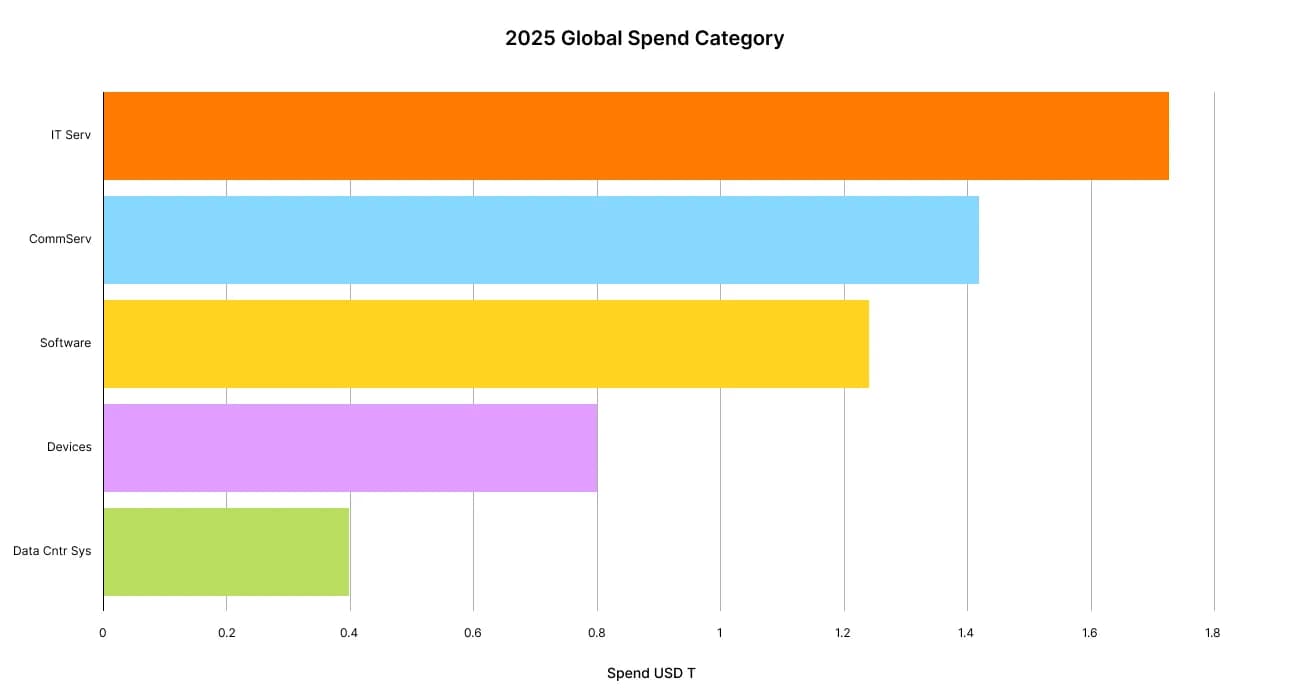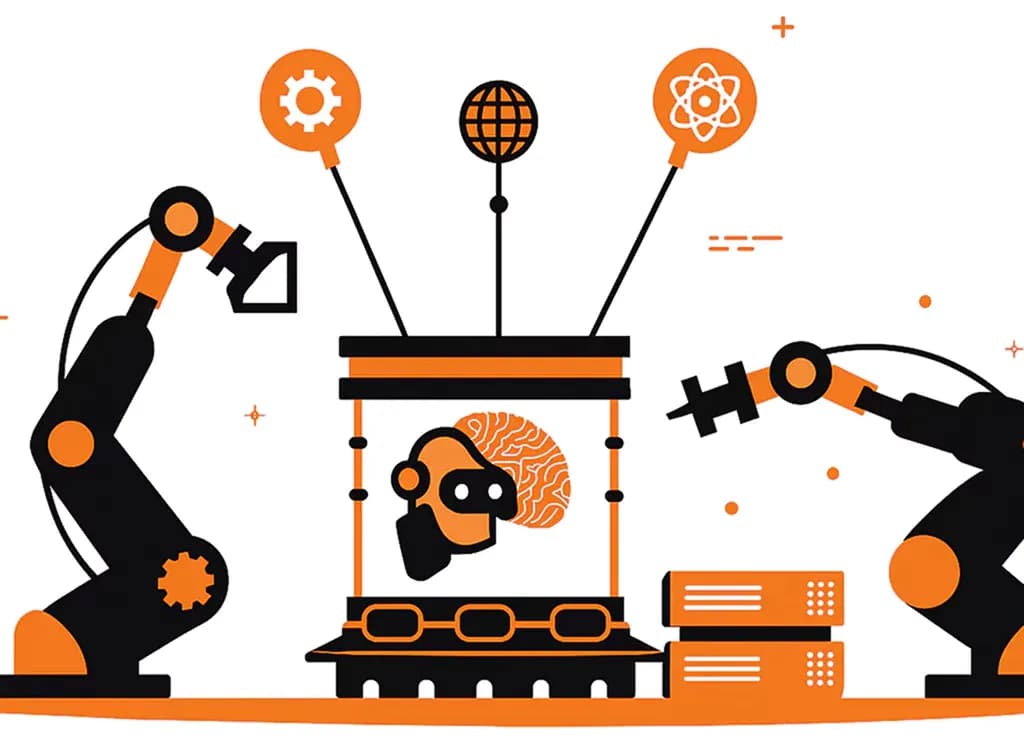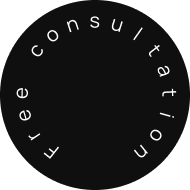Back
Updated at: October 11, 2025
Digital Transformation and Legacy Systems Modernization: Strategic Trends and Market Insights for 2025

The digital transformation landscape in 2025 marks a pivotal shift: global initiatives are accelerating with unprecedented intensity. Organizations are moving beyond experimentation into full-scale modernization - embracing AI-driven automation, composable architecture, and cloud-native development to remain competitive in a digital-first economy.
Spending trends reflect this momentum. Global digital transformation investment is projected to hit $1.77 trillion in 2025, with a trajectory toward $5.03 trillion by 2030. In the U.S., 88% of enterprises now extract real business value from their digital initiatives, a dramatic increase from the previous year. Meanwhile, 62% of organizations still rely on legacy systems, despite growing risks to security, resilience, and innovation.

From $1.42 trillion in 2024 to $5.03 trillion by 2030, digital transformation market growth is exponential.
Market Landscape and Growth Projections
Explosive Market Growth and IT Investment
The digital transformation market is expanding at a CAGR of 23.4% (2024–2030). As organizations race to modernize infrastructure and processes, global IT spending is forecasted to reach $5.61 trillion in 2025 - a 9.8% increase from 2024.

Worldwide IT Spending by Category 2025: IT Services Lead at $1.73 Trillion
AI infrastructure upgrades play a central role:
- AI-optimized server spend will reach $202 billion, doubling traditional server investment.
- Data center systems are expected to grow 39.4%, driven by AI and hybrid cloud.
- 94% of organizations worldwide are pursuing digital transformation in some form.
Regional and Industry-Specific Trends
- Europe: IT spending to grow 8.7% YoY, reaching $1.28 trillion, the fastest growth since 2021.
- MENA: IT investment will hit $175.5 billion, reflecting steady digital adoption.
- AI in the Enterprise: By 2025, 67% of AI spending will go to embedding AI in core operations, outpacing investments by cloud-native providers. AI is no longer experimental - it’s operational.
Emerging Technologies and Innovation Trends
Hyperautomation and Process Intelligence
Hyperautomation has moved from emerging trend to operational backbone. The market is expected to reach $49.5 billion in 2025, with North America accounting for 45% of global share and Asia-Pacific growing fastest at 38% CAGR.
Key enablers:
- Process Mining: Increases automation value by 40%, reduces implementation time by 50%
- Digital Twins: Market to reach $36 billion, helping simulate and optimize systems
- Low-Code/No-Code Platforms: Expected to power 70% of new applications by 2025, enabling non-developers to automate workflows
Enterprises report:
- 35–40% shorter development cycles
- 71% increase in deployment frequency
Generative AI in Legacy Modernization
AI-driven modernization is transforming legacy systems:
- Automated Code Refactoring: GenAI tools suggest clean alternatives while preserving logic
- Intelligent Documentation: AI generates documentation for complex, undocumented systems
- Dependency Mapping: Machine learning uncovers hidden architectural interdependencies
- Security Remediation: AI tools flag and fix vulnerabilities in outdated codebases
With technical debt averaging $361,000 per 100,000 lines of code, the ROI on AI-assisted modernization is immediate:
- 40% faster time-to-market
- 30% reduction in operational costs

AI agents and robotic automation represent enterprise automation and digital transformation's future.
Composable Architecture and API-First Development
Modern enterprises are shifting from rigid, monolithic systems to composable architectures made up of modular services.
Benefits include:
- Agility: Reconfigure services to respond quickly to market shifts
- Interoperability: Integrate best-of-breed tools via APIs
- Reduced vendor lock-in: Swap out individual components without replatforming
The API-first model - popularized by Amazon’s internal mandate in 2002 - is now a best practice, facilitating innovation through loosely coupled services.
Cloud-Native Modernization and Containerization
By 2025, over 95% of digital workloads will run on cloud-native platforms, compared to 30% just four years earlier.

Diagram of Kubernetes control plane and worker nodes for container orchestration and microservices management.
Drivers include:
- Elastic scalability: Adapt to demand surges automatically
- Resilience: Fault-tolerant microservices reduce system-wide outages
- CI/CD acceleration: Faster release cycles and faster innovation
- Cost optimization: Pay-as-you-go pricing with improved infrastructure efficiency
Serverless computing is also surging: the global serverless market will grow to $21.1 billion by 2025, supporting flexible, event-driven architectures.
Legacy System Modernization: Strategies and Frameworks
Structured Modernization Frameworks
Leading organizations follow methodical approaches to modernization:
- Assessment & Inventory: Profile legacy applications using automated tools
- Strategic Roadmap: Define business-aligned phases and KPIs
- Validation & Testing: Run pilots to mitigate migration risks
- Phased Execution: Use automation and CI/CD for iterative rollout

Legacy application modernization strategy comprises seven steps from examination to optimization.
Core Modernization Approaches
Depending on scope and risk, companies typically choose:
- Rehosting: Lift-and-shift to cloud with minimal changes
- Replatforming: Minor optimizations to leverage cloud features
- Refactoring: Update codebases for performance and scalability
- Rearchitecting: Rebuild apps with microservices and cloud-native components
Replacing: Move to SaaS or off-the-shelf solutions
AI-Enhanced Modernization Strategies
Deloitte identifies three emerging AI-enhanced patterns:
- Process Optimization: Automate IT workflows with AI agents
- Digital Core Reengineering: Redesign platforms to support real-time data and distributed AI
- Business Reimagination: Use AI to unlock new capabilities, from personalization to autonomous operations
Microservices, Kubernetes, and Industry Use Cases in Legacy Modernization
Monolith-to-Microservices: Challenges and Solutions
Migrating from monolithic systems to microservices offers flexibility and resilience - but the path isn’t simple. As of 2025, 45% of organizations report limited or no success with microservices adoption, primarily due to technical complexity and organizational inertia.

Microservices architecture with Docker containers showing client apps, microservices, databases, and event bus communication in a development environment.
Key challenges include:
- Distributed complexity: Service discovery, network latency, and error handling become harder
- Data decentralization: Splitting databases across services introduces consistency and governance risks
- Cultural shift: Teams must move from centralized IT to cross-functional squads with DevOps ownership
- Performance overhead: More services mean more inter-service calls and monitoring requirements
Patterns for Successful Migration
Despite the hurdles, many companies succeed using proven strategies:
- Domain-Driven Design (DDD): Define services based on business domains to reduce coupling
- Strangler Fig Pattern: Incrementally replace monolith components without downtime
- Database Decomposition: Use "database-per-service" patterns for cleaner data ownership
- Service Mesh: Tools like Istio or Linkerd handle observability, retries, and zero-trust security at scale
Organizations embracing microservices report:
- 3–5x faster release cycles
- Improved system resilience and modularity
Kubernetes and Cloud-Native Orchestration
Kubernetes is now the backbone of cloud-native infrastructure. It enables consistent, scalable deployment across public, private, and hybrid clouds. By 2025, over 95% of digital workloads are deployed on cloud-native platforms.

Microservices architecture on Kubernetes shows application pods and MySQL stateful set within a namespace.
Benefits of Kubernetes include:
- Declarative configuration: Manage infrastructure as code
- Self-healing and auto-scaling: Applications recover from failure and scale with demand
- Rolling updates: Zero-downtime deployments with rollback options
- Built-in service discovery and load balancing
Companies leveraging Kubernetes in modernization projects report:
- 40% increase in operational efficiency
- Significant gains in deployment speed and reliability
Industry-Specific Modernization Use Cases
Financial Services
Financial institutions lead in modernization due to regulatory pressure and digital competition. They often:
- Begin with non-critical workloads (CRM, data analytics) before touching core banking
- Adopt multi-zone resilience to maintain uptime across cloud regions
- Use data segmentation for regulatory compliance and privacy
Outcomes:
- Faster product launches
- Resilience against market volatility
- Improved personalization and customer experience
Healthcare
Over 60% of U.S. hospitals still run legacy applications - despite mounting security and interoperability demands.
Modernization drivers:
- Patient safety: Outdated systems increase clinical risk
- Compliance: HIPAA and GDPR demand encrypted, interoperable systems
- Data exchange: APIs and FHIR standards improve cross-provider collaboration
ROI highlights:
- Reduction in medical errors
- Enhanced security posture
- Integration with telehealth and mobile platforms
Manufacturing
Manufacturers use IoT and digital twins to transform operations:
- Edge computing enables low-latency data analysis near equipment
- Digital twins simulate real-world operations to optimize maintenance and quality control
- AI detects defects and predicts failures before they impact output
By 2025, 70% of industrial leaders use digital twins in production environments.
Government and Public Sector
Modernizing government systems means balancing innovation with public accountability. Key strategies include:
- Multi-tenant architecture for data isolation
- Open standards to avoid vendor lock-in
- Citizen service modernization through digital portals and mobile apps
Challenges:
- Budget constraints
- Legacy integrations with aging systems
- Governance and cybersecurity compliance
Common Challenges and Strategic Solutions
Modernization Obstacles
Top barriers include:
- Security vulnerabilities: Legacy systems lack modern encryption and patching
- System incompatibility: Outdated protocols don’t integrate well with cloud-native platforms
- High maintenance costs: Aging software demands niche expertise and manual upkeep
- Talent shortage: Skills in COBOL or mainframe systems are disappearing
McKinsey estimates technical debt will cost enterprises $5 trillion by 2030 if not addressed.
Mitigation Strategies
To succeed, organizations must:
- Adopt incremental modernization to limit disruption
- Use AI tools to analyze codebases, flag risks, and recommend architectures
- Invest in training to close internal skill gaps
- Partner strategically with vendors experienced in large-scale migrations
Change management is equally critical:
- Start with pilot programs to validate technology choices
- Ensure automated testing is in place for regression control
- Maintain business continuity plans throughout transitions
- Align stakeholders with transparent communication and training
Business Impact and Return on Investment (ROI)
Tangible Value from Digital Transformation
Digital transformation is no longer theoretical - it’s delivering measurable results. Companies with high digital maturity and strong AI capabilities are seeing 2–6x higher shareholder returns than their less digitally advanced counterparts.

Digital transformation ROI shows 45% improvement in Customer Satisfaction.
Top quantified outcomes include:
- +45% in customer satisfaction
- −40% in time-to-market for new offerings
- +35% in employee productivity
- −30% in operational costs
- +25% in revenue growth
Organizations are no longer asking if transformation creates value - they’re focused on how to scale and sustain that value across the enterprise.
Operational Efficiency and Cost Optimization
Modernization directly translates into operational efficiency and cost savings:
- Automation and RPA reduce infrastructure management time by 67% and improve resource utilization by 58.7%.
- Cloud migration leads to 28.3% average infrastructure cost reduction, while improving agility and availability.
- Case in point: enterprises using Azure PaaS report 228% ROI over three years and a 50% acceleration in application delivery.
- Legacy modernization reduces annual maintenance costs by an average of $41,600 per application, with most projects achieving ROI within 12 months.
In essence, modernization is now an investment that pays off fast - technically, operationally, and financially.
Revenue Growth and Business Model Innovation
Digital transformation is also a growth engine. According to recent surveys:
- 89% of large enterprises expect digital initiatives to contribute to at least 31% of future revenue.
- However, many fall short of expectations without a clear monetization strategy.
Key revenue accelerators include:
- Data monetization: Leveraging AI and analytics to launch data-driven products, personalize offerings, and optimize pricing.
- Platform business models: Creating multi-sided ecosystems that connect partners, customers, and developers - producing network effects.
- Digital product development: Expanding into SaaS, subscriptions, mobile-first tools, and APIs.
- Ecosystem partnerships: Extending market reach through integrations and co-innovation.
Organizations that rethink their core offerings digitally often unlock new markets, new customer segments, and entirely new revenue streams.
Technology Adoption Trends and Market Evolution
Adoption Rates (2024 → 2025)
The adoption of modern technology continues to surge across enterprises:
|
Technology |
2024 Adoption |
2025 Projection |
|
Cloud Infrastructure |
92% |
95% |
|
AI & Machine Learning |
77% |
85% |
|
RPA/Automation |
65% |
75% |
|
Microservices |
55% |
65% |
|
Containerization |
48% |
58% |
|
Edge Computing |
35% |
45% |
This reflects a broader shift toward scalable, flexible, and intelligent systems.

Key trends in legacy system modernization include mobile technologies, AI-powered analytics, containers, data modernization, automation, cloud migration, and DevOps.
Emerging Technologies
- Edge + 5G: Ultra-low latency infrastructure is unlocking real-time use cases in IoT, autonomous systems, and smart cities.
- AI Agents: Beyond automation, intelligent agents will begin making autonomous decisions across workflows. By 2025, expect early adoption in operations, customer service, and supply chains.
- Low-Code/No-Code (LCNC): By 2025, 70% of all new applications will be built using LCNC platforms.
Benefits of LCNC include:
- Development cycles reduced to hours or days
- Less dependency on specialized talent
- Greater innovation at the edge of the business (citizen developers)
- Global scalability across teams and regions
Market Players, Platforms, and Ecosystem Shifts
System Integrators and Consulting Leaders
The modernization market is dominated by global integrators and consultants with cross-domain expertise:
- IBM, Accenture, Cognizant, TCS, Infosys: Full-service digital transformation portfolios
- Kyndryl, Rocket Software: Deep specialization in mainframe and legacy systems
Notable developments:
- Rocket Software acquired OpenText’s Application Modernization business for $2.275 billion, strengthening its compiler and migration stack.
- Oracle and Microsoft expanded their joint Oracle Database on Azure offering to five new regions (March 2025).
- NTT DATA committed $10B+ toward expanding global data center capacity.
Cloud Providers
- Microsoft Azure: Leading in modernization tooling and SLA-backed partner frameworks.
- AWS: Continues to dominate in breadth and scale, especially in India and global finance sectors.
- Google Cloud: Focused on data-driven transformation, particularly in Europe and AI-native workloads.
- Oracle Cloud: Preferred for enterprise-grade workloads requiring Oracle database integration.
Specialized Vendors
Legacy and application modernization specialists include:
- DevOx Software: GenAI-enhanced refactoring with 30% faster delivery
- Inoxoft, Taazaa, Smyth Group: Custom legacy-to-cloud modernization
- OutSystems, Mendix, PowerApps, AppSheet: Leading LCNC platforms with enterprise-grade scalability
Startups to watch:
- Stride: AI-based code transformation and technical debt analytics
- Skan.ai: Digital twin for enterprise processes and automation opportunity mapping
- WorkFusion, Hyperscience: End-to-end hyperautomation platforms
Strategic Outlook Through 2030
Tech and Industry Evolution
What’s next for digital leaders?
- AI Agents at Scale: By 2028, up to 15% of business decisions will be made autonomously by AI, fundamentally reshaping operations.
- Quantum Computing: Expected to impact logistics, optimization, and cybersecurity use cases as early as 2029.
- Extended Reality (XR): Gradual enterprise adoption in training, design, and customer experience over the next 5–7 years.
- Green IT: Cloud platforms already reduce carbon footprints by up to 84% versus on-premise - sustainability will become a procurement priority.
Sector-Specific Outlook
- Financial Services: Focus on real-time AI, digital KYC, embedded analytics, and regulatory-grade auditability.
- Healthcare: Emphasis on patient safety, FHIR-based data exchange, and AI in diagnostics.
- Manufacturing: Expansion of Industry 4.0 - AI + IoT + digital twins + edge computing.
- Public Sector: Modernization of citizen services with emphasis on privacy, interoperability, and cost-effectiveness.
Strategic Imperatives for 2025+
To lead in the decade ahead, organizations must:
- Invest in AI readiness: Infrastructure, models, governance, and skills
- Build workforce capabilities: Upskilling is no longer optional
- Think in ecosystems: Compete and collaborate through APIs, platforms, and shared innovation
- Prioritize security: From DevSecOps to zero trust, compliance is foundational
- Commit to continuous transformation: Modernization isn’t a project - it’s a permanent discipline
Transform Ambition into Execution
Your modernization strategy should do more than update systems - it should unlock growth, agility, and resilience.
At We Can Develop IT, we partner with forward-looking companies to turn complex digital transformation goals into measurable business outcomes.
Ready to reduce costs, accelerate time-to-market, and future-proof your operations?
Let’s build the roadmap - and deliver it.
Summary:
The landscape of digital transformation continues to evolve as organizations prioritize modernization to maintain competitiveness in a digital-first economy. Investment in digital transformation is projected to increase significantly, with global spending expected to reach substantial figures in the coming years. Despite this growth, a notable percentage of organizations still depend on legacy systems, which poses risks related to security and innovation. AI-driven solutions are becoming integral to modernization efforts, enhancing processes such as code refactoring and documentation while reducing operational costs and time-to-market. The adoption of composable architectures and API-first development is gaining traction, enabling greater agility and interoperability among services. Additionally, cloud-native platforms are anticipated to host the majority of digital workloads, further supporting operational efficiency. Emerging technologies like hyperautomation and low-code/no-code platforms are reshaping development practices, making it easier for non-developers to participate in automation initiatives. Industry-specific modernization trends are evident across sectors like finance and healthcare, where upgrading legacy systems is critical for compliance and improved service delivery. Organizations are increasingly recognizing the tangible benefits of digital transformation, including enhanced customer satisfaction and reduced operational costs. As the market continues to evolve, strategic imperatives for future growth emphasize the importance of AI readiness, workforce capabilities, and a commitment to ongoing transformation.
Read also:
digitaltransformation
legacysystemmodernization
modernizationstrategies
enterpriseIT
cloudmigration
AIautomation
hyperautomation
lowcodeplatforms
nocodeplatforms
composablearchitecture
APIfirstdevelopment
Kubernetes
microservices
serverlesscomputing
processintelligence
generativeAI
digitaltwins
infrastructuremodernization
ITtrends2025
marketinsights2025
enterprisemodernization
AIpoweredtransformation
ITspendingtrends
enterprisecloudadoption
modernizationframeworks
refactoringsystems
digitalROI
businessagility
cloudnativedevelopment
DevOps
systemintegrators
applicationmodernization
modernizationroadmap
digitalmaturity
enterpriseresilience
futureofIT




